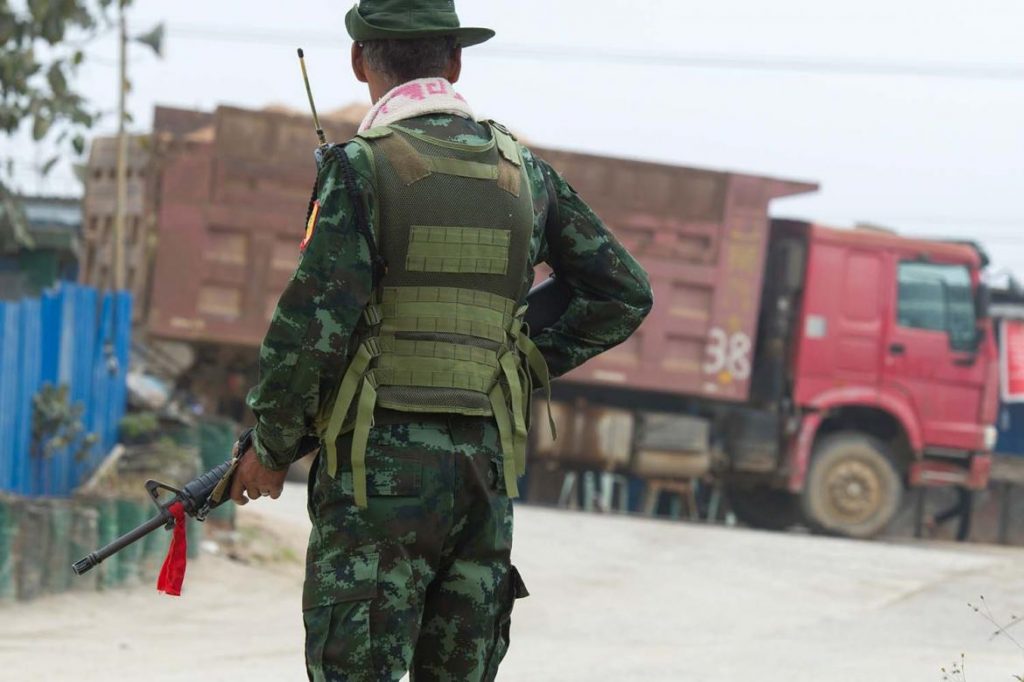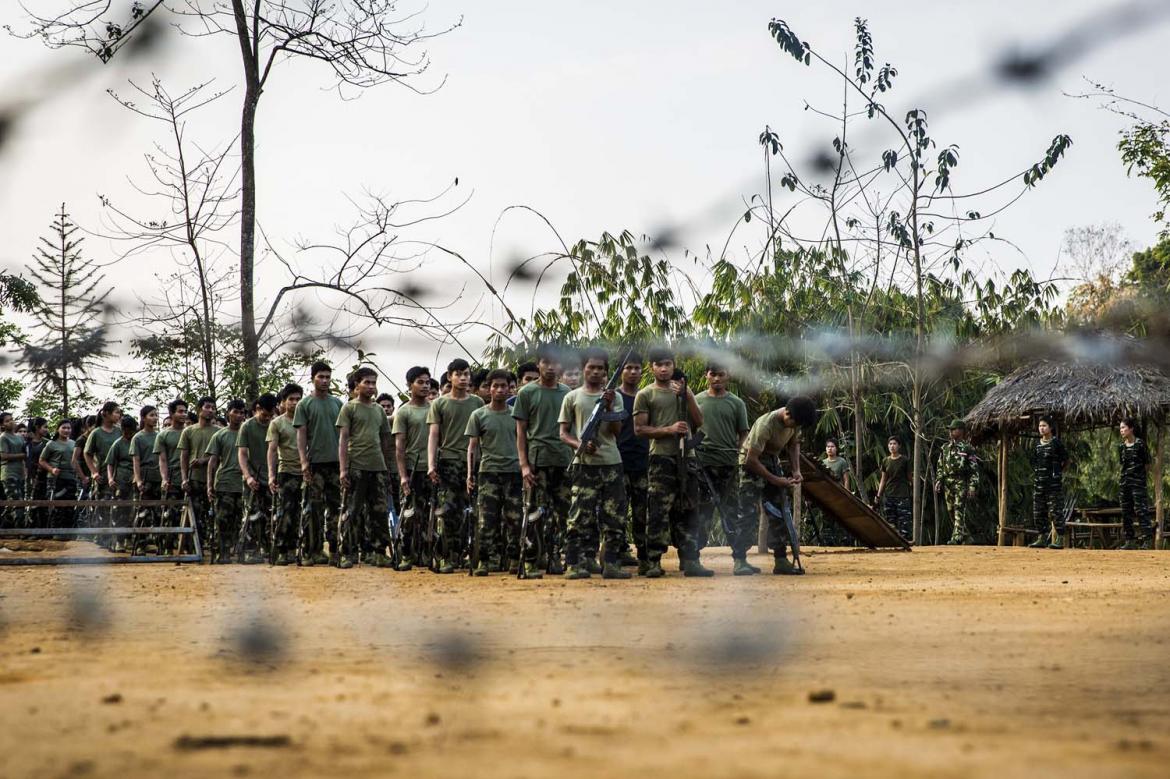Recurring conflict and military stalemate in northern Myanmar have prompted China to embark on a bold experiment – one with implications that Nay Pyi Taw might not yet even comprehend.
By YUN SUN | FRONTIER
WHEN VIEWING the domestic conflicts of a sovereign nation, China sees development and stability as two mutually reinforcing concepts. Instead of focusing on the fair and just distribution of political and economic rights, China prioritises making the economic pie larger so that everyone gets a bigger share.
This approach reflects China’s own experiences in strengthening political stability through economic development. Enhanced economic performance validates the legitimacy of the state and improves stability, which in turn creates conditions for further economic development.
This development-oriented approach towards conflict resolution has resulted in northern Myanmar’s conflicts becoming intrinsic components of China’s ambitious Belt and Road Initiative,
The rationale
China has been formally involved in the mediation of ethnic conflicts in northern Myanmar since early 2013, when it established the office of Special Envoy for Asian Affairs. Six years of mediation in Myanmar – during which there has been no agreement over the mechanisms and structure of the peace process, or the distribution of political and economic power in the ethnic states – has shepherded the Chinese to a few key conclusions.
Support more independent journalism like this. Sign up to be a Frontier member.
First, the complicated history and the fundamental lack of trust between the Bamar-dominated central government and ethnic minorities means it is not feasible to open negotiations on the most difficult issues, particularly power distribution. In this climate of mistrust and hostility, it is unrealistic to expect elites on both sides to make the concessions necessary for a peace deal.
Second, negotiations are elite-led and top-down. The general public on both sides are excluded and do not share a strong economic or political incentive to buy in to or strengthen the peace process.
Third, since negotiations started at the elite level are unlikely to succeed, a possible alternative peace strategy is a bottom-up approach focused on creating economic ties between people.
Last, but not least, is that public buy-in and economic development in areas controlled by ethnic armed groups will diminish incentives for these groups to continue fighting, particularly given the risk of economic disruption.
In summary, economic development and intra-Myanmar economic integration could have a stabilising effect that mitigates military conflicts and eventually paves the way for political integration and genuine peace.
This last point – of gradually weakening the ethnic armed groups’ willingness to fight – is particularly important. In the Chinese perception, one of the key reasons for the determination of these groups to fight is the protection of their economic interests, particularly those associated with natural resources. The fear that the central government and the Tatmadaw will exploit such resources has convinced these groups that a peace deal would eliminate their livelihood and leave little hope for their future. If alternative and better sources of economic growth and income could be developed and solidified, they would look at the natural resources issue in a new light.
The Chinese believe that strengthening economic growth in ethnic regions will also change the balance of power between the ethnic groups and the Tatmadaw. In their reckoning, a key factor fuelling the conflicts is the Myanmar military’s belief that the ethnic armed groups cannot afford sustained conflicts due to their limited resources. However, the inconvenient truth for the Tatmadaw is that it is unable to eliminate the ethnic armed groups on the battlefield. The military’s unrealistic expectations have created continued but failed attempts to win the war decisively, leading to a dynamic of recurring conflict and stalemate.
One way to change this equation is through strengthening the capability of the ethnic groups and forcing the Tatmadaw to accept the reality that it is impossible to win in the war. Only then could the political will to negotiate emerge. The strengthening of the ethnic groups’ capability does not have to be through military means, as economic development will enhance their comprehensive power while delivering the stabilising effect mentioned above.
The action
The policy shift to economic development as a means of conflict resolution has been reflected over the past year in China’s approach to northern Myanmar more broadly. The China-Myanmar Economic Corridor and the peace process intersect on three border economic cooperation zones that have been approved, named for the cities of Myitkyina, Ruili and Lincang. The three economic cooperation zones are centred on individual land gates: the Houqiao-Kanpiketee crossing, between China’s Tengchong city and the Kachin State capital Myitkyina; the Ruili-Muse gate in northern Shan State; and the Mengding-Chinshwehaw gate close to the Wa and Kokang regions. They are also all in areas controlled by the Myanmar government.
These economic zones are focused primarily on enabling border trade, agricultural production and infrastructure development between China and the ethnic areas in northern Myanmar. For the 5,000-acre Myitkyina zone, the priority is agricultural production, especially rice and cattle, and some light industry. The Lincang zone has received a US$250 million loan from Asian Development Bank primarily focused on addressing constraints to border trade. China envisages significant benefits for Myanmar’s ethnic regions, enabling farmers, traders and others to benefit from trading zones, logistics parks, schools, hospitals, and technical and vocational education and training. In the Chinese calculation, the Lincang zone will serve as a demonstration project of how peace and development can be achieved elsewhere in Shan and Kachin states.
The reception
The ethnic groups in northern Myanmar warmly welcome the tilting of Chinese development attention to ethnic areas and have applauded the diversification (if not reorientation) of China’s economic efforts away from the Myanmar’s lowland areas. Ethnic armed groups in northern Myanmar have proposed that the upside-down-Y-shaped design of the China-Myanmar Economic Corridor be revised to a rotated H (or工) shaped plan, with the upper arm stretching along the China-Myanmar border with Kachin and Shan states on either side, and the lower arm stretching toward Rakhine State and Yangon Region like in the original CMEC plan. Although it has not been officially revised, the new border economic zones are a sign that CMEC is heading in this direction.
The border economic zones will not only enhance border trade, but also turn ethnic areas into new corridors for economic activity between China and lower Myanmar. This will strengthen the socio-economic development of the ethnic regions and increase their importance in Myanmar’s national economy. Perhaps more importantly, the Chinese willingness to focus on and invest in the economic development of ethnic areas conveys a tacit but significant message of support and endorsement of the ethnic armed groups and their rights. With the Chinese deepening their economic buy-in and embedding their interests in the peace and stability of the ethnic regions, they will be much more likely to opposed the Tatmadaw’s military offensives. Such expectations might be inflated, but it does not negate the fact that China is publicly entrenching its interests in the conflict zones.
The grand development proposal also serves Chinese interests well. The military conflicts in northern Myanmar have long hindered development like that envisaged in CMEC. The attacks in Shan State, especially near Ruili, have severely disrupted border trade and bilateral economic activities. By bringing ethnic regions into CMEC, all parties have a stake in safeguarding the stability of the region. If stabilisation is achieved, one of the major obstacles to the CMEC through Myanmar will be removed.
Local governments in Yunnan province are keen to pursue opportunities arising from the Belt and Road Initiative and have strongly advocated for the border economic zones as a part of the CMEC. Local prefecture governments of Lincang, Tengchong, Baoshan and Ruili are playing up these economic development plans to substantiate their ambition to become China’s regional transportation and trade hubs for Southeast Asia, South Asia and the Indian Ocean.
So far there has not been any major reaction from the National League for Democracy government or the Tatmadaw to China’s development plans in the ethnic regions. This is not necessarily surprising: economic development is generally a benevolent concept and it would be politically incorrect for them to be seen to oppose it. However, one does wonder whether Nay Pyi Taw realizes that China is abandoning its former unofficial and secretive approach to the ethnic armed groups in northern Myanmar and is openly pursuing economic ties that will strengthen their capabilities.
These development plans will tie the ethnic regions even more closely into China’s economic orbit and institutionalise their positions in China’s regional plan. They will consolidate China’s political and security influence over northern Myanmar, and in the Chinese design demonstrate the appeal of Chinese investment in lowland areas such as Yangon and Mandalay. In the deepest Chinese calculations, if lowland Myanmar cannot be completely trusted and counted on, at least China will maintain its solid grip on upland Myanmar.
The conclusion
China is shifting its strategy towards conflict resolution in Myanmar and experimenting with a completely different approach. The approach is embedded in the idea that economic development can have a near-term stabilising effect, and economic integration will bear a long-term dividend in the form of reconciliation. Compared to the elite-centred, top-down style peace negotiations, this development-oriented approach is focused on the people and hopes to create momentum for genuine reconciliation from the bottom-up. The shift represents China’s new strategic calculations, and reflects a consensus in the various Chinese agencies.
Will this approach succeed? Nobody knows. After all, we are yet to see a single civil war that has been resolved successfully through economic development and integration of different communities. The fostering of economic growth runs the risk of emboldening the ethnic armed groups and deepening hostility between ethnic regions and the rest of the country.
Even in China’s own case, economic integration between the mainland and Taiwan has not yet brought the political reconciliation that Beijing desires. China’s record of economic development in ethnic minority areas in Xinjiang and Tibet has not produced peace and stability. But given that other political and military options have been unsuccessful, the longer approach of stabilisation through economic development may not be the worst idea – and certainly deserves the attention of everyone with an interest in Myanmar’s future.







